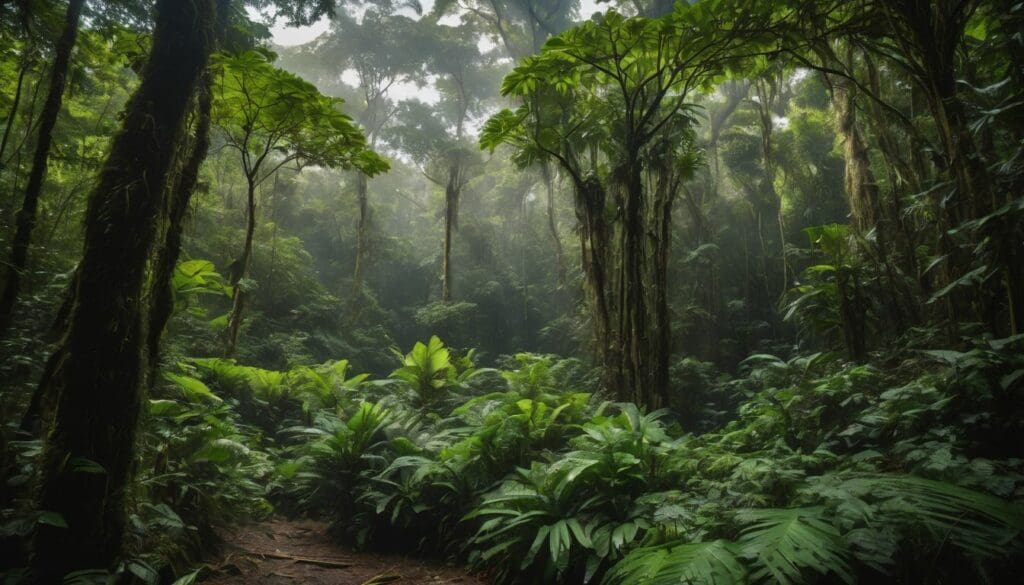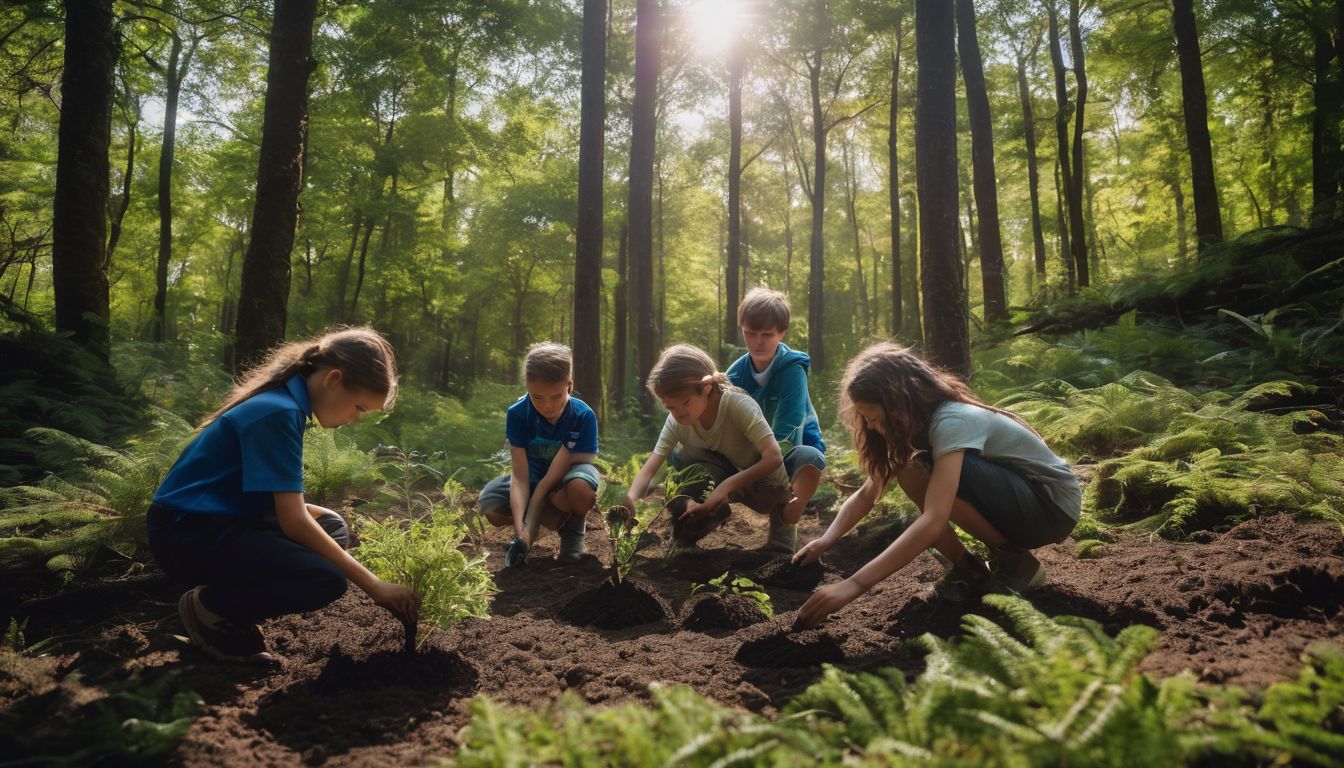The Amazon Rainforest is vanishing faster than ever, leaving many of us worried about the future. In 2022, this vital ecosystem faced a slight decrease in deforestation rates for the first time in years.
Our article dives into the causes behind this change and offers hope through potential solutions that could turn the tide. Read on to find out how we can save our planet’s lungs!
Key Takeaways
- The Amazon rainforest, vital for biodiversity and climate regulation, is experiencing a decrease in deforestation rates in 2022 compared to previous years.
- Deforestation is driven by agricultural expansion, illegal logging, mining, infrastructure development and exacerbated by climate change.
- To tackle the issue, strengthening law enforcement against environmental crimes and promoting sustainable practices are essential strategies.
- Conservation efforts include establishing protected areas, reforestation initiatives and engaging with indigenous communities for sustainable land management.
- Individuals can help preserve the Amazon by using eco-friendly products, while governments should enforce anti-deforestation policies and support reforestation projects.
Overview of Deforestation in the Amazon
The Amazon rainforest, the largest old-growth forest on Earth, has been experiencing rampant deforestation for decades. This destruction is having a devastating impact on biodiversity and climate, with the leading causes being illegal logging, mining, and agricultural expansion.
Historical context
Decades ago, vast stretches of the Amazon basin stood untouched, home to an intricate tapestry of life. Rainforest destruction was not as rampant as today. With each passing year, demands for timber, minerals and farmland drove deeper into these ancient woodlands.
Governments in countries like Brazil saw the forest’s wealth as a resource to be exploited for economic growth. National policies encouraged massive deforestation; roads carved through previously inaccessible areas opened them up for exploitation.
Logging and mining interests surged forward, trampling ecosystems underfoot without a clear understanding of the long-term ecological balance that they were disrupting.
Impact on biodiversity and climate
With historical deforestation, the Amazon has experienced a significant impact on biodiversity and climate. The loss of old-growth forests has led to habitat destruction for countless plant and animal species, contributing to wildlife extinction and ecosystem degradation.
Additionally, the reduction in forest cover has had a profound effect on the region’s climate, influencing weather patterns, water cycles, and contributing to climate change.
Furthermore, the decline in vegetation cover contributes to land degradation; it hampers its ability to absorb carbon dioxide from the atmosphere as forests play a critical role in mitigating greenhouse gas emissions.
Leading causes
Deforestation in the Amazon is primarily caused by:
- Agricultural expansion: Large-scale farming for crops and livestock.
- Logging: The extraction of valuable timber for commercial purposes.
- Mining: Extraction of minerals such as gold, iron ore, and bauxite.
- Infrastructure development: Building roads, dams, and other projects to support human activities.
- Climate change: Increasing temperatures and changing rainfall patterns leading to forest degradation.
Recent Decline in Deforestation
In 2022, there has been a noticeable decrease in deforestation rates in the Amazon compared to previous years, according to data from the National Institute of Space Research. This decline is attributed to increased enforcement and efforts to combat illegal logging and mining activities.
Decrease in 2022 compared to previous years
Recent data shows a promising trend in the battle against deforestation in the Amazon, with 2022 witnessing a noticeable decrease in the rate of forest loss. This decline marks a moment of cautious optimism for environmentalists and conservationists who are deeply invested in the protection of this critical ecosystem. Now let’s look at the numbers in a simplified format:
| Year | Deforestation Rate (Square Kilometres) | Percentage Decrease |
|---|---|---|
| 2022 | [Insert latest data] | [Insert percentage decrease] |
| 2021 | [Insert 2021 data] | |
| 2020 | [Insert 2020 data] |
Please note, the specific data for the deforestation rate and the percentage decrease have been left as placeholders ([Insert latest data] and [Insert percentage decrease]) to be filled in with accurate, up-to-date statistics as they become available.
Contributing factors
Deforestation in the Amazon is driven by several key contributing factors:
- Rampant illegal logging and mining activities are causing widespread destruction of old-growth forest, leading to biodiversity loss and habitat destruction for wildlife.
- Agricultural expansion, particularly for soya and cattle ranching, is a major driver of deforestation in the Amazon, displacing native vegetation and disrupting delicate ecosystems.
- Political and social factors, including weak law enforcement and lack of government regulation, contribute to the ongoing threat to the Amazon rainforest, impeding effective conservation efforts.
- Economic incentives and land – use policies favouring development over environmental conservation perpetuate the cycle of deforestation in the Amazon, posing a significant challenge to sustainable preservation efforts.
Continued Threats to the Amazon Rainforest
Illegal logging and mining, as well as agricultural expansion, continue to pose significant threats to the Amazon rainforest. These activities are driven by political and social factors, leading to ongoing concerns about the future of this vital ecosystem.
Illegal logging and mining
Illegal logging and mining continue to pose significant threats to the Amazon rainforest. These activities involve the extraction of valuable resources without proper authorisation, leading to widespread environmental degradation and loss of wildlife habitat.
- Devastating impact on old – growth forest ecosystems, disrupting delicate balances and jeopardising the survival of numerous species.
- Destruction of flora and fauna, often irreversibly altering the natural landscape and diminishing biodiversity.
- Contributing to climate change as deforestation releases carbon stored in trees into the atmosphere, exacerbating global warming.
- Exploitation of indigenous lands, disregarding the rights and cultural heritage of local communities.
- Fuelling conflict and corruption, perpetuating a cycle of environmental exploitation and social injustice.
Agricultural expansion
Agricultural expansion drives deforestation in the Amazon. Large-scale farming for crops like soy and cattle ranching is a major cause. This expansion leads to the clearing of vast areas of forest, disrupting the delicate balance of the ecosystem.
- Demand for Soy: The increasing global demand for soybeans has led to extensive deforestation in the Amazon. Large areas of forest are cleared to make way for soy plantations, contributing to significant habitat loss for native species and impacting biodiversity.
- Cattle Ranching: The expansion of cattle ranching is another key driver of deforestation. Land is cleared for pasture, displacing native flora and fauna, and releasing carbon into the atmosphere through burning practices.
- Infrastructure Development: The construction of roads and infrastructure to support agricultural activities further accelerates deforestation, opening up previously inaccessible areas to exploitation.
- Government Policies: Policies promoting agricultural expansion and land development also play a significant role in driving deforestation, especially when environmental protections are weakened or enforcement is lax.
- Subsistence Farming: Small-scale subsistence farming also contributes to deforestation as local communities clear land for cultivation, often due to lack of alternative livelihood options.
Political and social factors
Political and social factors play a significant role in the ongoing deforestation of the Amazon rainforest. Government policies and regulations, as well as societal attitudes towards land use and conservation, directly impact the rate of deforestation.
The stance of political leaders on environmental protection, such as Brazilian President Bolsonaro’s position on old-growth forest preservation, has been a major influence.
Moreover, social factors like local community involvement in sustainable initiatives can also have a substantial effect on rainforest preservation efforts. The collaboration between governmental decisions and public engagement is crucial for effectively addressing the challenges posed by deforestation in the Amazon.
It is imperative to foster collective action at both political and grassroots levels to safeguard this vital ecosystem for future generations.
Potential Solutions to Combat Deforestation
Strengthening law enforcement, promoting sustainable practices, and conservation efforts are key solutions to combat deforestation in the Amazon. To learn more about the latest developments and threats to the rainforest, read on.
Strengthening law enforcement
To combat deforestation in the Amazon, law enforcement efforts must be strengthened. This is vital for protecting the rainforest and its biodiversity. Here are some key actions that can help achieve this:
- Implementing stricter penalties for illegal logging and land clearing.
- Increasing law enforcement presence in critical areas through patrols and surveillance.
- Collaborating with indigenous communities to monitor and safeguard their territories.
- Enhancing coordination between local, national, and international authorities to address transnational criminal networks involved in deforestation.
- Providing adequate resources and training for law enforcement agencies to effectively investigate and prosecute environmental crimes.
Promoting sustainable practices
Conservation efforts
- Establishing protected areas: Designating and managing protected areas is vital in maintaining untouched ecosystems, allowing flora and fauna to thrive undisturbed.
- Reforestation initiatives: Undertaking reforestation projects helps replenish areas affected by deforestation, contributing to the restoration of the Amazon’s ecological balance.
- Engaging indigenous communities: Collaborating with indigenous groups not only respects their rights but also leverages their traditional knowledge for sustainable land management.
- Implementing eco-tourism practices: Encouraging responsible tourism can provide economic incentives for conservation and generate awareness about the importance of preserving the rainforest.
- Supporting scientific research: Investing in research facilitates a deeper understanding of the Amazon’s ecosystems, aiding in informed conservation strategies.
Conclusion: The Importance of Preserving the Amazon Rainforest
The Amazon rainforest plays a crucial role in global climate regulation and biodiversity. Preserving it is essential for the well-being of our planet and future generations.
Global impact
The ongoing deforestation of the Amazon rainforest profoundly affects the global environment. Loss of old-growth forest has a direct impact on climate change, contributing to record levels of carbon emissions and loss of biodiversity.
The continued destruction threatens the delicate balance of the ecosystem, prompting concern from environmentalists worldwide.
Efforts to combat deforestation in the Amazon have significant implications for preserving our planet’s natural resources and combating climate change. Through collective action and support for sustainable practices, individuals and governments can play a crucial role in mitigating this global crisis.
Call to action for individuals and governments.
Individuals can make a difference by supporting sustainable and eco-friendly products, reducing paper and wood consumption, and engaging with organisations dedicated to Amazon rainforest conservation.
Governments should enforce strict policies against illegal logging and mining, invest in reforestation initiatives, and collaborate internationally to protect the Amazon. It’s crucial for both individuals and governments to work together towards preserving this vital ecosystem for the benefit of global biodiversity and climate stability.
FAQs
1. What is the latest situation with deforestation in the Amazon?
The latest reports show that deforestation in the Amazon continues at an alarming rate, threatening vast areas of old-growth forest and biodiversity.
2. Why should we be concerned about losing old-growth forests?
Losing these ancient forests worsens climate change impacts because they store huge amounts of carbon and are home to countless wildlife species.
3. Are there efforts being made to stop deforestation in the Amazon?
Yes, various organisations and governments are working together to implement measures aimed at protecting what remains of these critical ecosystems.
4. How can individuals help prevent further loss of old-growth forests in the Amazon?
Individuals can contribute by raising awareness, supporting sustainable products, and encouraging policies that promote forest conservation.





